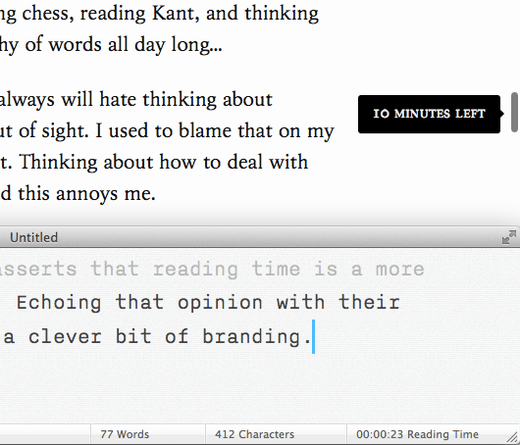
Neat detail on the iA blog (iA are the makers of iA Writer): When you scroll the page while reading an article, a small call-out tells you how much reading time is left – a subtle hat tip to the reading time feature in the app.
iA Writer is opinionated. It asserts that reading time is a more useful measurement than pages. Echoing that opinion with their blog is a charming detail and a clever bit of branding.

Marcus Swope
on 25 Jul 12This reminds me of federal documents that list the “Estimated Burden Time” on the top of the first page.
GeeIWonder
on 25 Jul 12Unless iA Writer is smart enough to judge the content (not just the number of words), the iA Writer, opinionated as it may be, is wrong.
Sounds like a ‘neat detail’ conceived by people who don’t read or, worse, think.
David Andersen
on 26 Jul 12Maybe, GiW, it’s based on the pace you’ve been reading at…
David Andersen
on 26 Jul 12...nope, it’s not. Looks to be based strictly on word count. The pace of scrolling does not change the estimated time.
Mathew Patterson
on 26 Jul 12“10 minutes” means less to me than “2 pages”; I know how long it takes me to read a page, the software apparently does not.
It would be great if it was based on real data and not a guess.
Oliver Reichenstein
on 26 Jul 12It is impossible to predict exactly how much time one will spend, because factual reading speed depends on reading skills, text difficulty, concentration, affinity to the content. Impossible to predict.
The goal is not to tell you exactly how long you need to read a text, but to give you an idea of how much time the average reader will spend on a text.
Opinionated or not, unless you are a journalist, reading time will tell you a lot more about the amount of text than a word count. We’ve been using it for ages, and people love it.
Pages will tell you something in a physical product, but on screens pages are completely random. Especially if you deal with large amounts of text.
Jura Ibl
on 26 Jul 12Yesterday I found same feature in Readability app for iPad, for me it’s nice detail. It’s corresponding with our perception of on-line content: date and exact time is useless now, content grow too fast. Because Twitter learned us think in seconds and minutes, so this trend make sense to me. In consuming as well as composing content.
GeeIWonder
on 26 Jul 12So your position is that something that is ‘impossible to predict’ is more informative then something that an integer.
I doubt this to be true.
Tom van Beveren
on 26 Jul 12The reading time on the iA blog helps me to decide when and how to consume an article. Quickly scrolling through an article not only gives me an idea of what’s in it, but it also tells me I can read it right now (± 2 minutes) or to send it to my readability read later list (> 2 minutes).
For me it’s a great feature because it builds upon my already existing behavior within my evolving way of consuming content on the web.
Laurian Gridinoc
on 26 Jul 12You can (brute force) estimate the time to read for a word, paragraph, full text, etc. by passing it through a text-to-speech program.
You can also categorize the text and assign (or learn) what mean speeds each category might have.
You can also track the user and learn his behaviour; the issue is that there are very few clues on how the user reads: scrolling behaviour and maybe mouse cursor movements (some people might use the cursor as a reading finger for couple times on a page).
But you cannot assess the sens of urgency the user might experience, and what does 2 minutes means in various contexts (waiting for the train or waiting for the dentist).
I’m into having the user set a deadline and compare to that, rather than imagining what 2 minutes are, see Timeboxing the News
Aurélien M.
on 26 Jul 12It’s intersting that some of you dislike the feature because it’s based on an estimation and not the real thing, but it does not bother you that the page count is also wrong. Just change the font size and you have one more page to read, but it’ll be quicker :)
I like the idea, and the simple fact of puting it in front of real people will provide them feedback for improvement, that’s the only way for us to improve dramaticaly on this.
anyway, I own their 3 versions of iA Writer (Mac/iPhone/iPad), I love the software and I’d kill for a Windows version to use @work !
Gareth Rees
on 26 Jul 12I wrote a rubygem to do this
Augie De Blieck Jr.
on 26 Jul 12Neat feature, but I don’t know exactly how long “IO Minutes” is. That first number is supposed to be a “1”?
Teja
on 26 Jul 12Damn, design geeks can be pedantic! If you show that to any normal person out there, I’m pretty sure they wouldn’t even think that the text read IO instead of 10 !
Clinton
on 26 Jul 12This is a great feature. I know Tim Ferriss does this at the beginning of blog posts so readers can gauge whether to read now or later. We’re flipping this on its head at Skim.Me to show you how much you’ve consumed instead of how much you have left (like time left or like RSS readers showing you how many unread there are).
Oliver Reichenstein
on 26 Jul 12It’s not “IO Minutes” but “10 MINUTES” set in small caps and… old style numbers.
Alessandro
on 26 Jul 12Sorry guys, but since when do people use word count to evaluate how much they have read? Just imagine: “Wow, I’ve just read 10.000 words of the Divine Comedy, need a pause.” This approach to “time management” is relative to the average user: if you know how fast you are at reading “10.000 words” still mean nothing to most people (maybe they do to copywriters?) but “10 minutes” is a much more useful piece of information. It’s also particularly useful if you write for a large audience where factual average reading time is more descriptive than the number of words, because you are supposed to use that to deduce reading time!
R
on 26 Jul 12http://www.markboulton.co.uk/journal/comments/this-post-wont-take-long-to-read
GeeIWonder
on 27 Jul 12Only if it’s correct. Which it is ‘impossible’ apparently to do (although several commenters have provided good algorithms, and I can think of a few others that might challenge this dogmatic point too).
500 words, if you know the content/context and are used to tracking this, lets you judge the pace/time yourself. Probably more correctly. The time ‘feature’ adds interpretation and subjectiveness that obfuscates the actual information, thus decreasing the signal and increasing the noise.
Alessandro
on 27 Jul 12Sorry, but I don’t think so. The length of a text of 500 Words—whereas a word can be as short as “of” and as long as “Pneumonoultramicroscopicsilicovolcanoconiosis”—is subject of interpretation anyway, because what you really want to know here is how much effort the reader is going to put in reading the whole text. Character and word count may mean something to copywriters and designers (and the information may be useful in that context) but the average reader reads on the web, on books and on magazines where those numbers, contrary to “time”, are not present. “500 words” are a language almost nobody speaks. If you know your reading speed “an average of 10 minutes” is more informational than “500 words” because you can relate to time much better than word count. “500 words” are data, not knowledge.
Alessandro
on 27 Jul 12By the way:
sorry for the lack of proper spacing but I’ve just now found out that i can use basic HTML tags!
Anonymous Coward
on 28 Jul 12So is your point that its the wrong data (i,e. Characters or syllables—which is btw a fallacy because people above the age of say 6 make extensive use of pattern recognitiom so ‘the’ and ‘if’ and ‘dictionary’ all take about the same time to read). Or is your point that the knowledge is the actual useable endpoint for a reader… In which case I agree but differ vehemently that a simplistic algorithm like this is in any way superior to knowledge derived by the reader from the same input data.
RF
on 30 Jul 12It’s also opinionated by assuming you’ll read straight through!
Mathew Patterson
on 31 Jul 12“The goal is not to tell you exactly how long you need to read a text, but to give you an idea of how much time the average reader will spend on a text.”
I don’t understand why I should care how long the average reader spends on something though? I care how long it will take me to read it. I have no idea how fast or slow the mythical “average reader” reads.
For me, the size of the scroll bar and the scroll thumb are actually useful. Not everybody understands that either of course.
Nik
on 01 Aug 12Reminds me of Vanity Fair in Italy. Each magazine article shows average reading time. Guess it helps to plan reading while at the hairdresser ;-)
This discussion is closed.